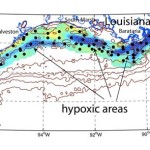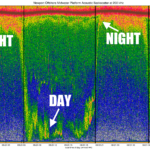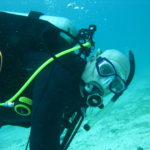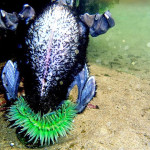In 2008, I wrote that about a paper by Chan et al. in Science examining the anoxic zone emerging off the Oregon coast. It was the first study to quantitatively assess the condition. Chan et al. found that from 2000-2005, hypoxic (low oxygen conditions) extended to shallow water but always remained above 0.5 ml/L. In 2006 conditions worsened with oxygen levels dropping to 0 ml/L. Submersible transects revealed zero fish, where prior transects contained diverse rockfish communities. Invertebrates exhibited almost complete mortality. The movie here is quite alarming. That post also provided photographs detailing a striking visual contrast of the area pre- and post-anoxia.
Later in 2008, Kevin reported about a study in Science documenting that “the number of marine [anoxic] “dead zones” around the world has doubled about every 10 years since the 1960s”. You can see the NSF produced video here.
In October 2009…the Pacific Deadzone off Oregon is likely irreversible.
the dead zone off the Northwest is one of the few in the world that could be impossible to reverse. That is because evolving wind conditions likely brought on by a changing climate, rather than pollution, are responsible, said Jack Barth, professor of physical oceanography at OSU…The gradual warming of surface waters across the north Pacific, the report funded by the National Science Foundation said, has tended to isolate deep waters far below the surface — allowing less oxygen penetration.There also has been a change in wind patterns, encouraging the upwelling of that low-oxygen water and inhibiting the natural flushing action of water.






upwelling of that low-oxygen water?
Deep water is lower in oxygen. When it gets upwelled, meaning the pushed up to the surface, at the coast it kills off the animal life that try to live in “that low-oxygen water”. Is this what you were asking?
Can any faculative or obligate anaerobic plankton/bacteria live in these pockets? (If they even exist?) Or are the just floating zones of death?